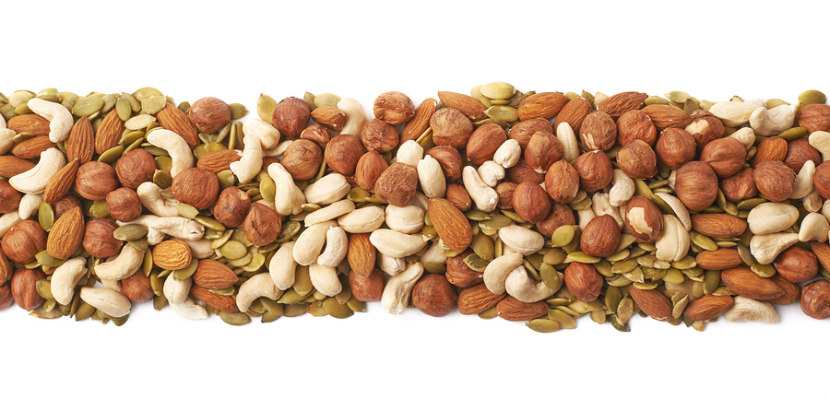
Nuts and seeds are a tasty way to eat more heart healthy nutrients such as fibre and unsaturated fat. They can help to add variety and flavour to your meals so that eating is even more nut-ritious!
Why are nuts and seeds good for your health?
-
The fat found in nuts and seeds is mostly the unsaturated type, which may help to reduce your risk of developing heart disease.
-
Eating nuts regularly can help reduce LDL cholesterol levels and may help reduce the risk of gallstone disease.
-
Eating nuts as part of an overall nutritious diet may help lower blood pressure and reduce the risk of some cancers.
-
Nuts and seeds have fibre, which keeps your bowels healthy and will also help you feel satisfied.
-
They are a good source of protein, which fills you up and keeps your muscles strong.
-
They contain important nutrients like magnesium, potassium and iron.
-
Many nuts and seeds contain antioxidants, which may help to protect against some diseases like cancer and heart disease.
How many nuts and seeds should I have?
One serving of nuts or seeds is about a ¼ cup or 60 mL. This amount should just fit into the palm of your hand.
If you prefer to use nut butters or spreads, one serving is equal to 2 tablespoons. This amount is about the size of your two thumbs.
Choose nuts that are raw or dry roasted (without oil) and free of added salt and sugar.
What is the nutrient content of some common nuts and seeds?
The nutrition information listed in this table is for one serving (1/4 cup/ 60ml) of the nut or seed.
|
Nuts
|
Calories (kcal)
|
Protein (g)
|
Total Fat (g)
|
Unsaturated Fats (g)
|
Fibre (g)
|
|
Almonds
|
208
|
8
|
18
|
16
|
4
|
|
Brazil
|
233
|
5
|
24
|
16
|
3
|
|
Cashews
|
182
|
6
|
14
|
11
|
1
|
|
Hazelnuts
|
189
|
4
|
18
|
16
|
3
|
|
Macadamia
|
244
|
3
|
26
|
21
|
3
|
|
Peanuts
|
210
|
10
|
18
|
15
|
3
|
|
Pecans
|
173
|
2
|
18
|
15
|
2
|
|
Pine
|
230
|
5
|
23
|
18
|
1
|
|
Pistachios
|
174
|
6
|
14
|
11
|
3
|
|
Walnuts
|
166
|
4
|
17
|
14
|
2
|
|
Seeds
|
|
Chia *
|
147
|
5
|
9
|
7
|
13
|
|
Flax
|
225
|
8
|
18
|
16
|
12
|
|
Pumpkin
|
189
|
9
|
16
|
12
|
1
|
|
Sesame
|
225
|
8
|
21
|
17
|
5
|
|
Sunflower
|
208
|
8
|
18
|
15
|
4
|
*Chia (or Salba) seeds are white or black seeds that are similar to flax seeds and can be found in the natural food section of your grocery store.
Did you know? Peanuts are not actually nuts! They are a member of the legume family and grow underground as part of a root system.
How do I use nuts and seeds?
Are you tired of peanut butter? Do you want new ideas for adding nuts and seeds to your diet? Nuts and seeds can be found whole, chopped, flaked or ground up into flour or nut butters. There are so many different ways to add nutty goodness to your meals and snacks. Give these ideas a try:
-
Try different nut and seed butters on your sandwiches. Cashew nut or sunflower seed butter can take your sandwich to a new level!
-
Increase the flavour of nuts by lightly toasting them. Place nuts in a dry frying pan over medium to high heat for 3-5 minutes. Nuts can burn quickly, so watch them carefully.
-
Spread tahini (from ground sesame seeds) on crackers or use it as a dip with fresh veggies. It is often found in hummus, but it is tasty on its own too.
-
Add crunch to fish fillets by sprinkling on chopped nuts like almonds or pine nuts before baking.
-
Sprinkle flax or chia seeds on yogurt, cereal or salads for some added fibre.
-
Add unsalted nuts to stir fries, noodles, rice or vegetable dishes
Recipes to try:
Almond Coconut Granola
Banana Nut Smoothie
Sweet Potato Toast with Nut Butter
Butternut Squash Pasta
Chicken in Mexican Mole
How can a dietitian help?
Dietitians can support you throughout many phases of your life from pregnancy to eating well when you are older. Counselling sessions with a dietitian can also help you to prevent and treat health conditions like diabetes and heart disease. Your dietitian will work with you to give you personalized advice that meets your lifestyle and goals. Connect with a dietitian today!
Bottom line
Nuts and seeds are a convenient and nutritious way to add protein, fibre, vitamins and minerals to any meal or snack.
You may also be interested in:
Vegetarianism FAQs
Phytonutrients – Nature’s Natural Defence
A DASH of Healthy Eating Can Help Reduce Blood Pressure
Facts on Fats
Top 5 Reasons to See a Dietitian
This article was written and reviewed by dietitians from Dietitians of Canada. The advice in this article is intended as general information and should not replace advice given by your dietitian or healthcare provider.
Last Update – December 7, 2022